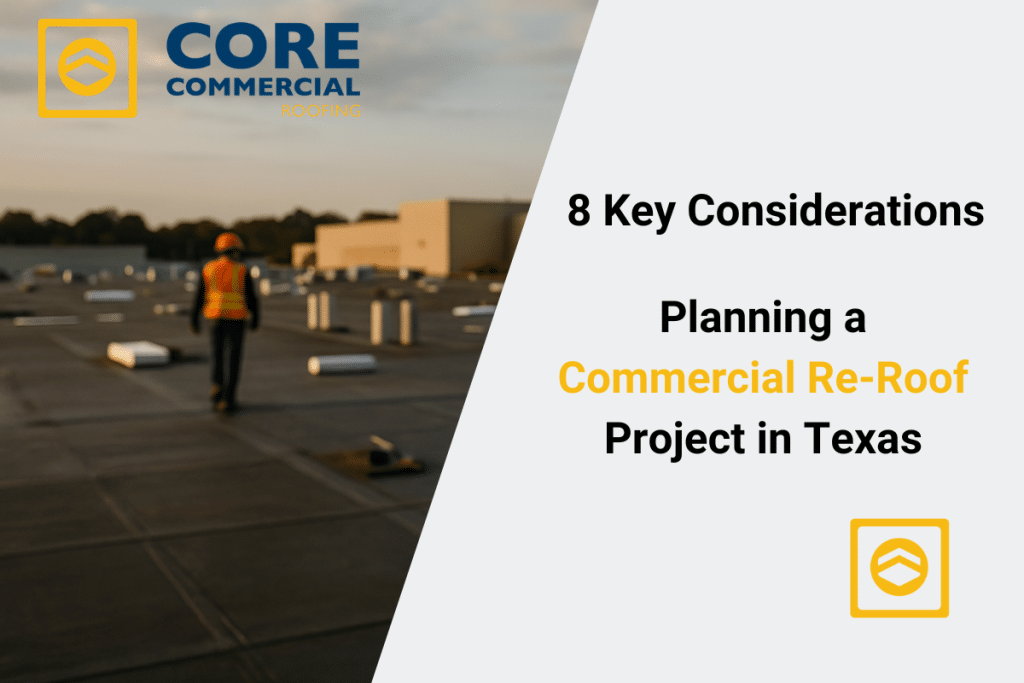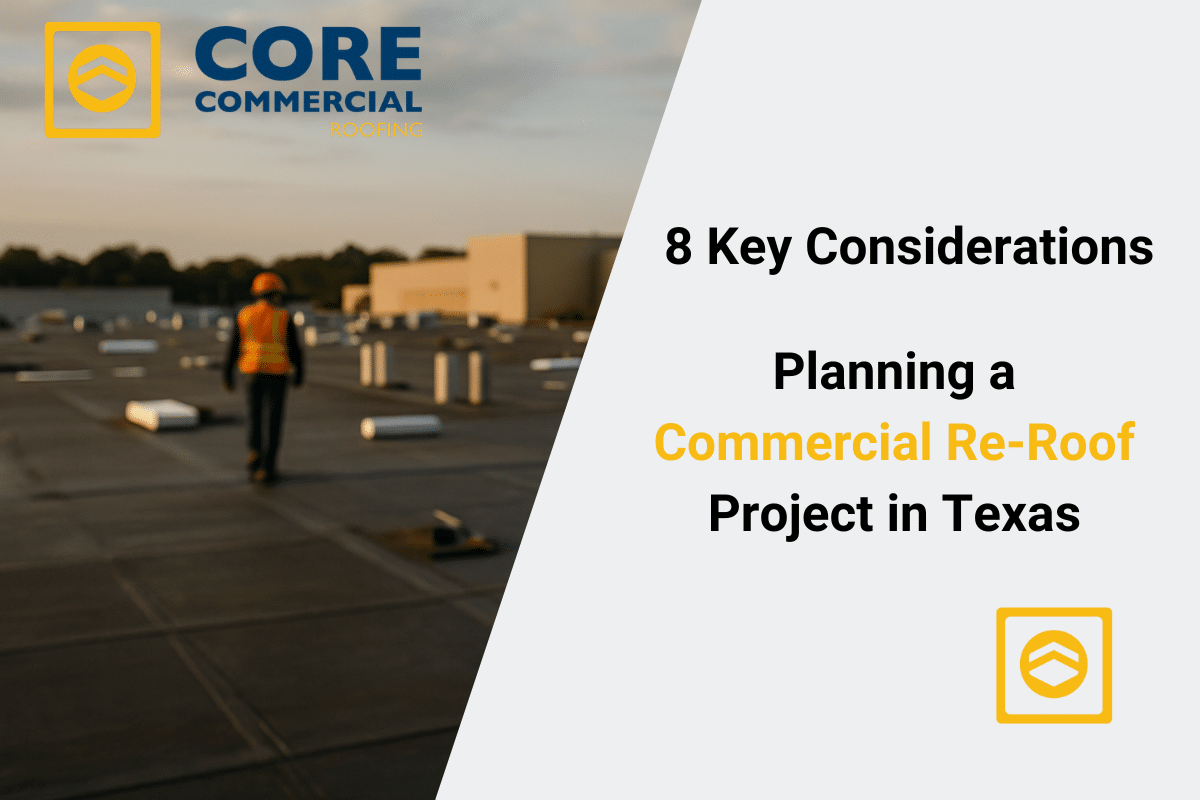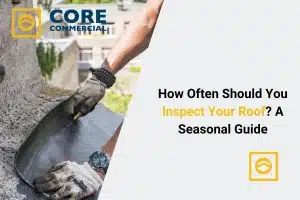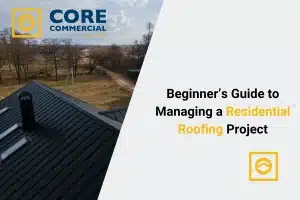Replacing a commercial roof is a major investment—and smart planning is your best defense against costly mistakes. Whether you’re facing leaks, age-related wear, or planning for energy efficiency, every decision made upfront will affect your long-term savings and roof performance.
This article covers the 8 most critical things to consider before starting your commercial re-roofing project, including one of our top recommendations: match your roof system to local weather patterns and city code requirements. Choosing the wrong system can lead to compliance issues or premature failure. Learn how to navigate building codes, select energy-efficient materials, and avoid emergency re-roofing caused by preventable damage. Make informed decisions now to avoid regrets later.

Table of Contents
1. Know Your Roof Type and Its Current Condition
You can’t plan what you don’t understand. Start by identifying what kind of roof you have and what shape it’s in.
Common Commercial Roof Types:
- TPO: Reflective and energy-efficient; common on flat roofs.
- Modified Bitumen: Durable and walkable.
- Metal: Long-lasting and hail-resistant.
- BUR (Built-Up Roofing): Multi-layered systems, often found on older structures.
Why It Matters:
Get a professional inspection first. Ask for:
- Moisture scans
- Core samples
- Photographic documentation
This helps determine if the existing system can be recovered or if a full tear-off is needed.
2. Understand Local Codes and Permitting Requirements
Texas doesn’t have a single statewide code—requirements vary city to city. What’s acceptable in one place may be rejected elsewhere.
What to Watch For:
- Layer limits (usually 2)
- Wind uplift resistance ratings
- Reflectivity or cool roofing standards
- Permit and inspection rules
Best Practice:
Always work with a contractor who understands your area’s permitting process and code enforcement. It saves time and costly rework later.
3. Account for Climate and Weather Risks
Texas weather is hard on roofs. You need materials and construction methods that stand up to real-world abuse—heatwaves, hail, wind, and flooding.
What to Plan Around:
- UV exposure: Breaks down many materials over time.
- Hail: Choose impact-rated systems for storm-prone regions.
- High winds: Especially critical for coastal or open areas.
- Rain events: Ensure drainage is designed for sudden downpours.
Bottom Line:
Your roof must handle today’s extremes and tomorrow’s surprises.
4. Choose the Right Roofing System for Your Building
Don’t assume what worked last time is still your best option. Your roof’s slope, insulation needs, and purpose all affect system choice.
| System | Pros | Cons |
| TPO | Reflective, affordable | Vulnerable to punctures |
| EPDM | Long lifespan, easy to repair | Absorbs heat |
| Metal | Extremely durable, hail resistant | Higher upfront investment |
| BUR | Thick and proven | Heavy and hard to modify |
| Modified Bitumen | Walkable and flexible | Needs UV protection |
5. Factor in Energy Efficiency and Long-Term Operating Costs
Energy-efficient roofing isn’t just good for the environment—it’s good for your bottom line. In Texas, where cooling is a major expense, roofing materials can help control interior temperatures.
Smart Upgrades:
- Reflective coatings (white TPO, silicone)
- High R-value insulation
- Radiant barriers
Why It Pays Off:
Lower monthly utility bills, better tenant comfort, and potential eligibility for tax credits or local rebates.
6. Prepare for Downtime and Minimize Disruptions
Re-roofing a building that’s in use? You need a plan that doesn’t stop business operations or upset tenants.
Minimize Impact With:
- After-hours scheduling
- Clear signage and safety barriers
- Communication plans for tenants and employees
- Dust and noise control procedures
Pro Tip:
Use a detailed project timeline that outlines who is responsible for what and when. This keeps surprises (and complaints) to a minimum.
7. Budget for More Than Just Labor and Materials
The initial quote isn’t the full story. Many projects run into issues because of unexpected costs.
Your Budget Should Include:
- Permit fees and inspections
- Tear-off and waste disposal
- Structural repairs or insulation upgrades
- Safety compliance and equipment
- Future maintenance or re-coating plans
Look long-term:
The cheapest option upfront could cost you more in repairs or replacements later.
8. Hire the Right Commercial Roofing Contractor
Roofing experience matters—but commercial experience matters more. These projects are bigger, more regulated, and more complex than residential jobs.
Look for:
- Licensed and insured in Texas
- References for similar commercial work
- Knowledge of local codes and climate
- Detailed bids with timelines and deliverables
Ask Smart Questions:
- “What coatings or materials do you recommend for my conditions?”
- “How do you handle inspections and code approvals?”
- “Do you offer warranty options?”
Tip:
A good contractor should educate you throughout the process, not pressure you into a quick sale.

Final Thoughts: Plan Smart for a Roof That Lasts
A commercial re-roofing project is one of the biggest capital expenses a property owner will face—but it’s also one of the most important. When planned correctly, it protects your building for decades, saves you money every year, and boosts your property’s value.
To recap, here are the 8 keys to success:
- Know your existing roof.
- Understand local regulations.
- Prepare for the local climate.
- Choose the right roofing system.
- Consider energy savings.
- Minimize business disruption.
- Budget realistically.
- Hire a qualified contractor.
Take your time during the planning phase. The more you invest upfront in making informed decisions, the less you’ll spend later fixing preventable problems.
FAQs
Is a permit needed to replace a commercial roof in Texas?
Yes, most Texas cities require permits for commercial roof replacements. For example, Houston mandates permits and on-site plans for inspections. Always check with your local permitting office to ensure compliance.
What are the best commercial roofing materials for Texas weather?
In Texas, materials like TPO, metal, and modified bitumen are popular due to their durability and energy efficiency. TPO is reflective and cost-effective, metal roofs offer longevity, and modified bitumen is flexible for varying temperatures.
How can I make my commercial roof more energy-efficient in Texas?
To enhance energy efficiency, consider installing reflective roofing materials like TPO or applying cool roof coatings. These options can reduce heat absorption, lower cooling costs, and improve indoor comfort.
How do I know if my commercial roof needs replacing?
Costs vary based on materials, roof size, and complexity. On average, prices range from $5 to $12 per square foot. Factors like insulation, labor, and permits can influence the total cost.
How long does a commercial roof last?
Lifespans depend on the material: TPO roofs last about 15-20 years, metal roofs can exceed 40 years, and modified bitumen lasts around 20 years. Regular maintenance can extend these durations.
How do I know if my commercial roof needs replacing?
Indicators include persistent leaks, visible damage, sagging areas, and increased energy bills. Regular inspections can help identify issues early and determine if replacement is necessary.
How can I find a good commercial roofer in Texas?
Look for contractors with experience in commercial projects, proper licensing, insurance, and positive reviews. Ensure they are familiar with local codes and offer warranties on their work.
Are there energy efficiency incentives for commercial roofs in Texas?
Yes, programs like the Commercial Property Assessed Clean Energy (C-PACE) offer financing for energy-efficient upgrades, including roofing. These can help offset initial costs and provide long-term savings.
What maintenance is required for commercial roofs in Texas?
Regular inspections, cleaning debris, checking for damage, and ensuring proper drainage are essential. Scheduling maintenance at least twice a year can prolong your roof’s lifespan.
Can I overlay a new roof over my existing commercial roof in Texas?
Texas building codes often allow one overlay, but it depends on the existing roof’s condition and local regulations. Always consult with a professional to determine the best approach.






